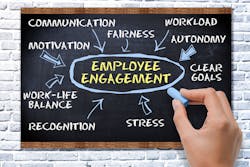Many managers have a love/hate relationship with performance reviews. They understand how these reviews can help employees become better at their jobs with focused goals, but they dread coming face-to-face with employees when there is a behavior or performance problem to address.
So, what are performance reviews?
“For most organizations in the United States, performance reviews are used to support decisions related to training and career development, compensation, transfers, promotions, and reductions-in-force or employment termination,” explains the Society for Human Resources Management (SHRM) in its online toolkit “Managing Employee Performance”: “Generally, the performance review process includes setting clear and specific performance expectations for each employee and providing periodic informal and/or formal feedback about employee performance relative to those stated goals.”
The group adds that recent trends are moving away from a formalized process and “focusing on more feedback and coaching.”
Recent trends are moving away from a formalized process and “focusing on more feedback and coaching.”
For wholesale distributors looking for advice and best practices on conducting effective performance reviews, the National Association of Wholesaler-Distributors (NAW) offers a “Developing Your Workforce” section on its website.
The article on performance reviews by Jia Wang says: “[R]esearch evidence tells us that to increase the effectiveness of performance review[s], we need to expandIn other words, managers and subordinates with positive and healthy work relationships result in feelings of trust, support, loyalty and commitment. When employees receive more positive reinforcement, they may see the performance review process as fair, even if they receive an unfavorable review.
“The way in which a supervisor delivered review results affected subordinates’ perceptions of the entire performance review system,” the NAW article notes. “If the supervisor shared performance ratings and feedback in a timely, candid, respectful and unbiased manner, supported by detailed explanations, then the employee perceived the process as fair and accepted the outcomes in a positive manner. [D]issatisfaction indicates that employees’ goals have not been fulfilled as reflected in the feedback they receive.”
Coaching and periodic feedback
Unfortunately, the performance review process is not well-organized at many companies.
“Typically, managers scramble at the last minute to document achievements and areas of improvement for each team member in order to provide an objective evaluation,” explains Oracle. “They then struggle to find individual performance information. Ultimately, they come ill-prepared to the annual review and take a check-the-box approach without realizing the bad impression it gives the employee. It’s a very time-consuming process each year and does little to improve performance.”
A once-a-year approach can catch an employee off guard with an unfavorable review, especially if the manager is unprepared.
“The fundamental tenet of performance evaluation systems is that people succeed best when they have concrete goals, ongoing feedback and clear links between individual performance and important organizational objectives,” explains the American Supply Association. “All employees must have a clear understanding of what is expected of their work performance, how their work performance is measured, how well they are meeting performance expectations and how they can improve their work performance.”
Streamlining this process through software is one option. At the very least, a few informal discussions throughout the year are beneficial — whether it’s to praise the employee for goal achievement or express concern about unusual low performance.
“[E]mployees don’t value a single assessment of performance,” the Oracle article notes. “In order to develop them and improve performance, they need to be coached throughout the review period, evaluated and recognized on smaller accomplishments. Coaching provides a better opportunity to improve performance because employees can see how evaluation of smaller achievements add up to the overall evaluation.”
SHRM agrees — an effective performance review system includes a “feedback process that is continuous and timely throughout the review period so that employees know how they are doing and what is expected.”
Best practices
NAW notes that small and mid-sized distribution firms “lag behind other industries in performance management.” It highlights five general guidelines for wholesale distributors to set up an effective performance management system.
1. Clarify the overall purpose. What do you expect from the performance review? Make sure you have that in mind as you start the review process.
2. Set SMART performance goals. SMART stands for specific, measurable, achievable, relevant and time-bound. Well-defined performance goals are important, but they should not be set in stone. The business environment is constantly changing, so goals should be re-evaluated throughout the year.
3. Select the right performance measures. There are four dimensions of evaluation: generic traits, work behaviors, knowledge and skills, and results produced. “[U]understand the pros and cons of each approach, and select one, or a combination, that will fit your performance goals and organizational needs,” NAW says.
4. Focus on the future. “While looking back may help you project future performance, it is a reactive approach in essence,” NAW notes. “Therefore, instead of focusing on what has not done well in the past, reorient your focus on what can be improved into the future.”
5. Seek employee feedback. This is where the quality of the relationship between manager and subordinate directly correlates to the perceived effectiveness of the performance review. “If employees react negatively to the way their work performance is measured, they are less motivated to perform better,” NAW explains.
Wholesale distributors must balance employee satisfaction with company goals. With ongoing coaching and feedback, employees won’t be blindsided at the formal performance review; they’ll know what is expected of them at all times. And managers will have continued insight into how subordinates are achieving goals or experiencing setbacks.
Kelly Faloon is a contributing writer to Contracting Business magazine and principal of Faloon Editorial Services. The former editor of Plumbing & Mechanical magazine, she has more than 20 years of experience in the plumbing and heating industry and more than 30 years in B2B publishing. Faloon is a journalism graduate of Michigan State University.
About the Author

Kelly L. Faloon
Freelance Writer/Editor
Kelly L. Faloon is a contributing editor and writer to Contracting Business magazine, Contractor and HPAC Engineering. The former editor of Plumbing & Mechanical magazine, Faloon has more than 20 years experience in the plumbing and heating industry. She started a freelance writing and editing business in 2017, where she has a varied clientele.
Faloon spent 3 1/2 years at Supply House Times before joining the Plumbing & Mechanical staff in 2001. Previously, she spent nearly 10 years at CCH/Wolters Kluwer, a publishing firm specializing in business and tax law, where she wore many hats — proofreader, writer/editor for a daily tax publication, and Internal Revenue Code editor.
A native of Michigan’s northern Lower Peninsula, Faloon is a journalism graduate of Michigan State University. You can reach her at [email protected].

